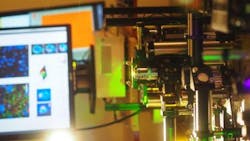Superresolution microscopy shows how deadly Nipah virus assembles
A team of researchers at the University of British Columbia (UBC; Vancouver, BC, Canada) used superresolution microscopy to observe how the Nipah virus (a deadly virus transmitted from animals to humans) and others like it assemble themselves in a much more haphazard manner than previously thought. The discovery could allow scientists to develop more effective vaccines and rule out many approaches to fighting these viruses.
Related: Superresolution microscopy unravels inner structure of herpes simplex virus
Chemistry professor Keng Chou and his team of researchers from UBC and Cornell University (Ithaca, NY) used a superresolution microscope patented by UBC to observe whether viruses actually assemble in the way scientists have hypothesized.
Nipah is an example of an enveloped virus, which gets its outer wrapping from the infected host cell, much like the viruses that cause influenza, rabies, measles, and AIDS. Nipah can cause severe diseases and fatal brain swelling in both humans and animals. Yearly outbreaks in southeast Asia kill 40-90% of those infected. In 2018, only two out of 19 people infected by Nipah in India survived an outbreak.
Nipah virus has three structural proteins: a matrix protein that provides structure, and two envelope proteins that enable the virus to attach and fuse with host cells. Scientists have believed that matrix proteins recruit envelope proteins, sending out some sort of signal so they can all join together on the cell membrane and become a functional virus. Researchers have tried to identify this signal in hopes of finding ways to disrupt the process.
However, Chou and his team observed that envelope proteins tend to be scattered randomly on the cell membrane. They now believe these proteins are picked up purely by chance when they are incorporated into a virus. This produces virus particles more quickly than previously envisioned, but many matrix proteins don't pick the envelope proteins up at all, and don't become functional viruses.
This observation has implications for vaccination not just against Nipah, but potentially against influenza, HIV, and other enveloped viruses. Vaccines work by exposing a person to a small amount of modified virus or viral proteins, which rallies the body's natural defense. Currently, there is no Nipah vaccine approved for human use. One of the potential strategies under development is to use virus-like-particles, which are protein-based structures that mimic viruses, to stimulate immune response.
"If a vaccine contains a large percentage of virus-like particles that have only the matrix protein but not the envelope proteins, it won't trigger a strong immune response to the proteins that are most essential for helping a virus enter cells," says Qian Liu, a postdoctoral fellow in UBC's chemistry department who was lead author of the study. "Vaccines could be made more effective if we find a way to exclude those non-functional particles from the mix."
Full details of the work appear in the journalNature Communications.
